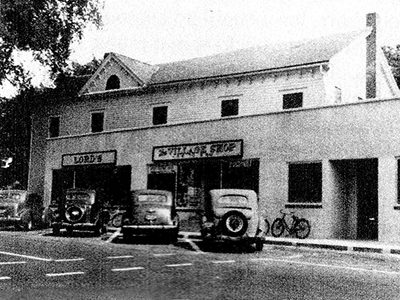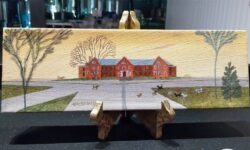[ccfic caption-text format="plaintext"]
Medfield was first granted a post office in 1807. It was located in the old Wheelock store on the corner of North and Main Streets, where Starbucks is situated today (the old store has since been divided into two sections and moved to #13/#17 South Street, where they are residences). Samuel Seaver, who ran the store, was the town’s first postmaster. He was a Federalist in the then-strongly-Federalist Commonwealth of Massachusetts. In 1809 the post office moved to the Clark Tavern at 353-355 Main Street (now facing demolition by neglect), with Ebenezer Clark as the new postmaster. A room in the Clark Tavern was used for the post office. Clark was hired to drive a stagecoach from Dedham, in which he brought the mail to Medfield.
In 1818, Willard Onion was appointed postmaster and the post office moved to Onion’s store on the southwest corner of Main and South Streets, where Brothers Marketplace is today. Onion had a post in the middle of his store where he kept pieces of tape. Here letters, which were held for delivery, were attached.
In 1820, Willard Onion died and Jonathan P. Bishop became the postmaster. Bishop had come to Medfield and taught at the North School when a young man. He later commenced the practice of law. In 1822, he moved to Illinois and was succeeded as postmaster by Willard Onion’s brother, Charles, with the post office staying in the Onion store.
In 1826, the post office moved across the street to the Johnson Tavern, now the site of town hall, where innkeeper Samuel Johnson became postmaster. He also drove the stagecoach and brought the mail into Medfield. In 1835, James Clark bought the Johnson Tavern, renamed it the James Clark Tavern, and took over the duties of postmaster. Clark was known throughout the region as a musician and instructor of dancing. He remained the postmaster until 1852, when James Whitney was appointed postmaster, with the post office staying in the James Clark Tavern.
In August of 1853, the post office moved one building to the west into the store of Isaac Fiske. Fiske’s store was located where Starbucks is today at the corner of Main and North Streets. Here, Walter Janes ran the post office from 1853 to 1862. Janes had established the manufacturing of straw hats, which would go on to become the leading business in Medfield for the next 100 years.
In 1862, Isaac Fiske took over as postmaster and continued to keep the post office in his store. Fiske would remain the postmaster until 1881. Fiske would also serve the town as state representative, town clerk from 1840-1853, and town treasurer for 34 years.
In 1881, Jeremiah B. Hale became the new postmaster and he moved the post office into the recently-built town hall (built in 1872, burnt in 1874, and rebuilt in 1874). He was assisted by Annie Codding and later Mabel Braman. Cost of a stamp at the time was two cents for a one-ounce letter.
In 1886, Frank Bonney was appointed postmaster. Bonney had fought in the Civil War and had served time as a prisoner in the infamous Andersonville Prison in Georgia. Bonney moved the post office to Frost Block on North Street (site of today’s Larkin’s Medfield Package Store). A newspaper article of the time reported: “The post office was open to the public in Frost’s Block. The room has been fitted up in a very neat shape by Postmaster Bonney. The frescoing is universally admired. The smiling face of Annie Codding appears again as post office assistant and she received a hearty greeting from a host of friends. Taken altogether, we consider the office to be large enough and central enough for all practical purposes.” In 1888 he moved the post office next door into the newly built Monks’ (Thayer) Block on the northwest corner of Main and North Streets.
In 1890, James Ord was postmaster, followed by Frank R. Moore in 1894, Henry Dunn in 1900, Robert Baker in 1911, and Edward Bent in 1914. Bent was commissioned postmaster by President Woodrow Wilson. Bent resigned as postmaster in 1922 and was replaced by Turner R. Bailey, with the post office moving back into town hall. When the town hall burnt for a second time in 1923, the post office was moved first to the Centre Railroad Station on Park Street, and then to the Unitarian Church on North Street until the rebuilt town hall reopened later that year. Turner Bailey had previously served as letter carrier on the Rural Free Delivery Route in Medfield. He served until 1936, when he was replaced by Joseph Scully.
The post office then moved across the street, from town hall into the wooden building located next to what was Lord’s Department Store. Later, a separate new post office was built in that same location in what is now the fountain/bakery section of Brothers Marketplace. In 1953, Postmaster Scully was replaced by Frank Haley, who had been serving as a Medfield selectman at the time.
The post office was again replaced in 1958, when a new brick post office was built on the corner of North Street and Janes Avenue, now occupied by Nosh and Grog Provisions. In 1965, President Lyndon Johnson nominated Francis “Frank” Woodlock to be Medfield’s postmaster, replacing acting postmasters William Griffin and Robert Finn. John Caruso was appointed postmaster in 1985 and Barry Clough followed him in 1988. It was during Postmaster Clough’s term that Medfield debated the building of a new post office.
In 1995, after several years of trying to find a downtown location for a new and larger post office, the town settled on the 58 North Street Plaza location occupied by Golden Rice Restaurant. When negotiations with the owners were unsuccessful, the Town Meeting approved an eminent domain taking of the land. In an unusual partnership, the Town of Medfield leased the land to the United States Postal Service for fifty years. The Town worked with the Postal Service to help design the new building. Finally, in September of 1998, the newly constructed post office, built on the now town-owned land, was opened for business, where it remains today.
Photos courtesy of Medfield Historical Society



























